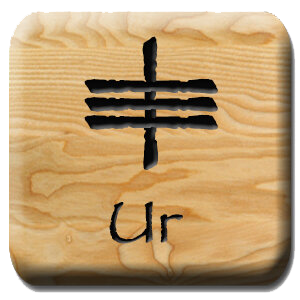
The Gaelic Tree Alphabet
‘Darach’ means Oak in Scots Gaelic so ‘An Darach’ means ‘The Oak’. However, there are other Gaelic words to describe an Oak, such as ‘Dair’ or ‘Duir’ which come from the more ancient Ogham (OH-am) alphabet.
Ogham was predominantly used to write the early Irish language and from the 6th century was used in the Gaelic Kingdom of Dalriada covering what is now Argyll, West Lochaber and the Inner Hebrides as well as the northern tip of Ireland.
The Ogham Alphabet
The Ogham alphabet is sometimes called the ‘Gaelic Tree Alphabet’ or ‘Celtic Tree Alphabet’ as each letter is assigned a tree or plant name. Perhaps this is because each of its characters, or ‘trees’ is made out of a vertical reference line, known as a flesc (flayshk) that looks a little like a stem or trunk with one or more slashes, or twigs protruding from it. Whilst the Ogham Alphabet has 20 letters and 20 trees associated with it, the Gaelic Alphabet has 18 letters and 18 trees.
The Gaelic Tree Alphabet
A is for Ailm (pronounced ‘A-lum’) and is predominantly associated with Elm, but also Pine and Fir
These tall straight trees are associated with perspective and height. In ancient Celtic tree lore, the Elm is intimately bound up with death and the transition into the Underworld, whilst evergreen Fir trees were associated with the healing of a person’s inner soul. The kind of elm that grows most widely in Scotland is Wych Elm. This refers not to witches, who were said to shun Elm trees, but refers to its flexibility taken from an Old English verb meaning ‘to give way’. As wood from the Elm is very flexible it consequently does not make a good material to construct buildings from. However, like Alder it does withstand water very well, so it has been popular in making boat hulls, bridges and wheels. Like Scots Pine, hollowed out Elm has previously been used as water piping before the advent of metal water pipes. Elm is also the material that coffins were traditionally made from. Welsh longbows too, were often made from Elm, whereas English longbows were more commonly made from Yew.
B is for Beith (pronounced ‘BAE-yh’) and is associated with Birch (particularly Silver Birch)
Known as ‘The Lady of the Woods’, in Celtic Mythology Birch represents purification, change and new beginnings, femininity, grace, purity, family connections, protection, healing, new life and rebirth. As Birch is one of the first trees to come into leaf it would be an obvious choice as a representation of the emergence of spring. The Birch is known as a ‘Pioneer Tree’ meaning that it can restart the colonisation of woodlands after long term natural disasters. According to Scottish Highland folklore, a barren cow herded with a Birch stick would become fertile.
Birch bark was used for tanning leather whilst Birch wood is tough, heavy and straight-grained, and was historically used to make infants cradles, cabinets and furniture. It is also used to make besom brooms, the archetypal witches’ broomsticks upon which they were said to fly (maybe due to the consumption of Fly Agaric mushrooms that typically grow beneath Birch trees in Autumn).
C is for Coll (pronounced ‘Col’) and is associated with Hazel
In Celtic mythology Hazel is associated with wisdom, creativity and knowledge. The Hazel is one of the very oldest native British trees. Traces of hazelnut shells and pollen have been discovered in cave settlements, dating back around 10,000 years.
Pliable, straight shoots called 'withies' grow up from the base and these are still cut for walking sticks and pinned into shape whilst growing, for shepherd’s crooks. Pilgrims often used to make staffs from Hazel, providing a sturdy walking stick and a means of self-defence. Hazel was also often used in weaving of baskets in medieval times.
August is known as the Hazel Moon as this is when Hazel nuts appear on the trees. The red spots on wild salmon were said to have been gained from the fish having consumed nine hazelnuts that fell into a pool from a surrounding grove.
D is for Dair (or Duir) (pronounced ‘Dahr’) and is associated with Oak
In Celtic mythology and lore, the Oak is associated with strength, resilience and self-confidence and is a great tree for enhancing inner strength, especially when you have experienced a great loss in life. It is said that the Oak tree helps build strength, resilience and self-confidence, and lends power so you might rebuild your life and move forward. For this reason, we consider the name ‘An Darach’ is a quite auspicious name for our social enterprise.
Oak has been valued for its strength and durability, and was commonly used in construction of homes and the bark has historically been used in the tanning industry. St. Columba was said to have had a fondness and respect for Oak trees and to have been reluctant to fell them, although his early chapel on Iona was constructed of Oak from the nearby Mull Oakwoods.
A well known Celtic symbol is the Dara Celtic Knot, usually featuring an interwoven design that represents the root system of an ancient Oak. Like other Celtic knots, the Dara Knot is made up of intertwined lines with no beginning or end.
E is for Eadha (pronounced ‘EH-ga’) and is associated with Aspen
Aspen is seen as a symbol of endurance, courage and the overcoming of obstacles. In the Highlands of Scotland, the Aspen was often rumoured to be connected to the realm of the Faeries and the Gaelic name Strontian, where the croft is located, is Sròn an t-Sithein meaning ‘Nose (or point) of the Faerie Hill. There was a Highland tradition of not using the wood from the Aspen for fishing or agricultural implements, or in house construction, suggesting that the Aspen was considered a faerie tree on a par with the Rowan Tree, the use of whose wood holds similar taboos. However, Aspen wood is very lightweight and when dried, becomes very buoyant, and was therefore historically a popular choice for oars and paddles. Weight for weight it also offers unrivalled protection and was the wood of choice for shields and armour. In Celtic mythology Aspen was also seen as providing spiritual protection as well, and the unique shape of the leaves creates a whispering sound in a breeze, which the Celts believed was the souls of their ancestors communicating.
F is for Feàrn (pronounced ‘Fyaarn’) and is associated with Alder
In Celtic Mythology Alder is often associated with water, secrecy, nature, bad luck, spirituality, and balance. Alder trees were also a source of great mystery to the Celts as their sap turns a deep red when exposed to the air, as if they could bleed when cut.
In Irish mythology Deirdre of the Sorrows fled to Alba (Scotland) with Naoise, son of Usna, to escape the wrath of the King of Ireland, Conchobhar mac Nessa to whom Deirdre had been betrothed. They are said to have hidden in the Alder woods of Glen Etive, contributing in part to the themes of hiding and secrecy connected with Alder in Celtic lore.
The wood from the Alder is oily and water resistant, turning hard when under water and so survives being submerged very well. Consequently and was often used for construction of buckets, water pipes, the foundations for bridges and other construction in wet conditions. Parts of Venice in Italy are built on top of Alder piles which were driven in to the Venetian lagoon. In Scotland crannochs (wooden strongholds built over the water of Scottish lochs) were built on rafts or piles of Alder trunks.
Like the Birch tree, Alder is considered to be a ‘pioneer’ tree, as it is often the first to colonise wet and treeless ground or to heal landscapes disturbed by fire, flood, clear cuts, or storms. It also has a unique characteristic that greatly improves the soil around it over the course of its life. The Alder forms a symbiotic relationship with a particular type of soil bacteria that takes up residence in their roots which have nitrogen fixing nodules in them. This bacteria enables the Alder to make better use of the nitrogen in the air, in return for which the Alder provides the soil bacteria with sugar. Its deep root system also helps to increase stability in river banks and other damp areas where the tree thrives.
A green dye can be derived from the flowers and was used to colour and thus camouflage the garments of outlaws such as Robin Hood, as well as the clothes of faeries, concealing them from human eyes.
G is for Gort (pronounced ‘GOR-ht’) and is associated with Ivy
In Celtic Mythology Ivy is often associated with prosperity and growth, and it is believed to be a bringer of good fortune, particularly to women. Allowing it to grow up the outside walls of your home was thought to protect inhabitants from magic and curses. However, if it should die or fall down then misfortune would befall those who lived there.
Ivy represented peace to the Druids who often related the Ivy with peace because of its ability to bind different plants together. It was frequently carried by young women for good luck and fertility, and today Ivy is often used at weddings, where it is seen to symbolise fidelity. The Faeries are reputed to love Ivy as, along with Heather, is said not to grow in the Faerie Realm accounting for why they like it so much.
H is for Huath (pronounced ‘HOO-er’) and is associated with Hawthorn
In Celtic Mythology the thorns of the Hawthorn are often associated with cleansing, protection and defence, although the stem of the Hawthorn is seen to bring bad luck if brought into the home. This is thought to be due to the fact that many species of Hawthorn give off a smell of death and decay when cut. Often called the Faerie Tree for it is said to guard the entrance to the faerie realm, the Scottish mystic and poet, Thomas the Rhymer, was said to have met the Faerie Queen under a Hawthorn tree. Having accompanied her into the faerie realm, he returned to find that he had been absent for seven years. In Celtic mythology the Hawthorn was one of the most likely trees to be inhabited by faeries, and it was said that Hawthorn trees could not be cut down or damaged in any way without incurring the often fatal wrath of their supernatural guardians. In Celtic Mythology, Faeries were not friendly little creatures that lived at the bottom of your garden but were feared and respected, with tales of kidnapping and curses abound, so the Hawthorn was usually treated with care and respect.
The famous Holy Thorn Hawthorn that grows on Glastonbury Tor is said to be a descendant of the one that grew where Joseph of Arimethea thrust his staff into the ground.
I is for Iogh (pronounced ‘Yoo’) and is associated with Yew
The Yew tree has come to symbolise death and resurrection in Celtic culture, perhaps because drooping branches of old Yew trees can root and form new trunks where they touch the ground or because of its unusual growth pattern, in which new growth forms inside the old. Alternatively it might be because the Yew has no medicinal value at all, and almost all parts of it are toxic to humans and animals. However, Yew trees themselves are capable of living thousands of years and aged ones are often found in churchyards or in places that had pre-Christian spiritual significance. The Fortingall Yew in Perthshire is thought to be between 2,000 and 3,000 years old (some say more) and is thought be one of the oldest trees in Britain if not in Europe..
The Yew produces a very hard, close-grained wood that has commonly been used in furniture making, but is perhaps best known as the material from which English longbows were made. The Scots also used yew longbows sometimes and Robert the Bruce is said to have ordered bows to be made from the sacred yews at Ardchattan Priory in Argyll, that were then used during the Scots’ victorious battle at Bannockburn in 1314.
L is for Luis (pronounced ‘LOO-sh’) associated with Rowan
The Rowan Tree (also known as the Mountain Ash) is often associated with humanity, perseverance, and life as well as insight, blessings and protection against enchantments and magic. Celtic druids believed that women were forged from the Rowan tree (as men were forged from the Ash tree) and so the Rowan symbolises the fragility of life, motherhood, birth, blood, protection, and survival.
Rowan trees are not tall and hence do not often grow in amongst taller trees, so are more commonly found growing singly. However, they can grow in shallow soil and at high altitude, making them common in the Scottish Highlands, often at altitudes where few other trees will grow. As the Celts believed that the veil between the heavens and the mortal world was thinnest on top of mountains where the land was closest to Heaven, this is perhaps why the Rowan has a special spiritual significance in Celtic Mythology.
The wood from the Rowan is strong and resilient, making excellent walking sticks, and was also often used for tool handles, spindles and spinning wheels. However, it is widely reputed to be unlucky to cut down a Rowan. A black dye can be extracted from the young tree bark, which contains a lot of tannin.
M is for Muin (pronounced ‘MOO-n’) and is commonly associated with the Vine, but also with the Bramble
Muin is a symbol of inward journeys and life lessons learned. There is disagreement about whether Muin should be associated with the Vine, which although featured in Bronze Age art, isn’t native, arriving in Britain when the Romans introduced wine 2000 years ago. The Bramble on the other hand is native to the cooler climate of Northern Europe and shares the winding characteristics and bares fruit like the vine. In Gaelic the Bramble is known as Dris-Muine, which means ‘Prickle Thorn’, further supporting this theory. This is why the Ogham Muin can represent the Vine or the Bramble.
The Vine is a symbol of both happiness and wrath and is connected to prophecy and truthful speaking, perhaps because of the behaviours of those under the influence of fermented grapes used to make wine. The Bramble is most commonly associated with Devil and it was said that the Celts didn't eat Blackberries as the Devil had spat on them. The association with Satan is also present in Christian mythology, where it was said that when Satan was banished from the Kingdom of Heaven, he fell in to a patch of brambles and cursed them as they pierced him. Goats are one of the few animals that eat brambles, and they are traditionally associated with Satan in Christianity, perhaps adding to the negative associations of the Devil with Brambles.
N is for Nuin (pronounced ‘NOO-n’) and is associated with the Ash tree
The Ash tree has long been a symbol with wisdom, knowledge, and divination. Celtic druids also believed that men were forged from the Ash tree (and women from the Rowan) contributing to its association with masculinity, strength and rebirth. In a number of legends, the Ash is connected to the gods, and considered sacred. In Norse legend, Yggdrasil, the World Tree, is considered to be an Ash tree with its root reaching far down into the Underworld, and its trunk reaching up into the heavens, and its branches spreading out across all the countries on Earth. The Norse God Odin hung from Yggdrasil for nine days and was rewarded with insight and wisdom.
Ash has historically been seen to have healing and protective properties. In British folklore newborn babies were often given a spoonful of Ash sap, whilst placing Ash berries in a cradle was thought to protect the child from being taken away as a changeling by mischievous Faeries.
Most recently, Ash wood was used to make stagecoach axles as it was said to bear more weight than any other wood. Further back in history spear shafts were often made of Ash, as were bows where Yew wood was not available. Asher, my surname, is usually believed to be an English and Germanic occupational surname for an ash maker, derived from the Middle English surname ‘Aschere’ or from German ‘Äscher’ (Ashman). In Old English it was used to mean someone who lived by an ash tree or ash grove. As a child I was told that it was derived from a Viking term for spear maker (perhaps by my Grandmother, but she also told me I was a quarter Cherokee so not to be totally believed!). However, The Old Norse for an Ash tree was ‘Askr’ and for a spear was ‘Atgeir’ so who knows, Asher may have meant spear maker!
O is for Onn (pronounced ‘OH-n’) and is associated with Gorse
In Celtic Mythology, Gorse (also known as Furze) was thought to provide protection against misfortune (and spiteful faeries - see below) and was also associated with resilience, optimism, as well as with the Sun, light, and fire. It seeks sunshine and warmth and is quick to sprout new shoots. To this day, it is often cleared using a controlled burn to allow new gorse to come through. In folklore there was a belief that protection from spiteful faeries could be achieved by completely barricading the space around your bed with gorse branches!
Gorse wood burns at a high temperature with a fierce flame, similar to charcoal, and for this reason it was often used as a fuel. The flowers of the gorse are bright yellow and can be used as a yellow dye for clothes. The gorse generally flowers from January to June, although it can flower sporadically throughout the year, and there is normally some gorse in bloom every month of the year, hence the saying 'when gorse is in bloom, kissing's in fashion'.
P is for Peith Bhog (pronounced ‘Payh fvog’) and is associated with Downy Birch
As previously mentioned when describing Beith, in Celtic Mythology birch was traditionally associated with birth, love and purity. Birch was often placed over cradles to keep the young safe from evil spirits and bundles of birch twigs were used to drive out the spirits of the old year.
Downy Birch is more upright than silver birch and the bark is browner in colour with more obvious horizontal grooves and lacking the papery quality of the Silver Birch. Silver Birch has hairless and warty shoots whereas downy birch shoots are covered in small, downy hairs. The range of Downy Birch is more northerly and westerly than Silver Birch, and it can grow at higher elevations. It can also grow further north than any other broadleaf species. In the Spring, the sap from the Downy Birch can be used to make refreshing drinks, wines, and ales.
R is for Ruis (pronounced ‘Roosh’) and is associated with Elder
Elder is often seen as representing endings, transitions and maturity in terms of the awareness that comes with experience. In both Celtic and wider British folklore, Elder is said to provide protection against malevolent faeries, witches and the Devil. It was thought that if you burned the wood from the Elder, you would see the Devil, but if you planted Elder by your house it would keep the Devil away. Traditionally, it was said that the best protection for a home was obtained by having a Rowan tree by the front door and an Elder tree at the back door.
Elder wood is hard and off-white. The mature wood is good for whittling and carving, while smaller stems can be hollowed out to make craft items such as beads or musical instruments. It is reputed that the Faery Folk love music and merrymaking, and most of all they like the music from instruments made of elder wood. Elder foliage was once used to keep flies away and branches were often hung around dairies in the belief that it would stop the milking from ‘turning’. The flowers can be used to make wine, cordial or tea.
Whilst the Elder is not a common tree in Scotland, many parts of the tree were used for dying in the Harris tweed industry, with blue and purple dyes being obtained from the berries, yellow and green dyes from the leaves, and grey and black dyes from the bark.
S is for Suil (pronounced ‘Sool’) and is associated with Willow
In Celtic culture and lore, the Willow was associated with knowledge, optimism, adaptability and spiritual growth. The ease with which a new tree can be grown merely by pushing a healthy branch cutting into the soil has come to symbolise renewal, growth, vitality and immortality in other parts of the world.
Willow trees were an important part of Celtic Mythology, and were thought of as sacred because they grow mostly on riverbanks and on the sides of lochs, both of which held special spiritual significance. Borders were important in Celtic culture, with the Rowan the most sacred for bordering the earth and the heavens, with Willow significantly going on the border between land and water.
Whilst in many cultures, the Willow has been associated with sadness and mourning, this was not the case in Celtic culture where Willow was known for its ability to relocate after being uprooted, either by nature or by man.
Much like the Alder, Willows are pioneer trees and they spread roots helping to stop soil erosion along banks in their natural, watery habitats. Willow has been harvested for wicker work and baskets, small coracles, and even bee hives were constructed with this bendable, flexible wood. Most famously they are used in the construction oil cricket bats and stumps. In the Nineteenth century, scientists discovered that the Willow contains salicylic acid, which is similar to the active ingredient in Aspirin.
T is for Teine (pronounced ‘TEEN-uh’) and is associated with Holly
As an evergreen, Holly was connected with immortality and a symbol of fertility and regeneration. Felling an entire Holly tree was said to have brought bad luck. However, the use of sprigs for decoration has always been allowed and holly has variously been brought into the house to protect the home from malevolent faeries or to allow faeries to shelter in the home without friction between them and the human occupants. Holly trees were also said to protect dwellings from lightening strikes if planted close to the home.
In folklore, the Holly was King of the Woods for half the year, ruling from the Summer to the Winter Solstices, at which time Holly was defeated by the Oak King who ruled until the Summer Solstice again. In this way Holly was seen as the rival of Oak for the favour of the Lady of the Woods, Birch, who switched her allegiance from Oak to Holly and then back again.
Whilst it now rare to see fully grown Holly trees, and more common to find it in hedges or as part of Oak or Beech woodland, large pieces of Holly wood have been used in furniture making and smaller pieces being used to make walking sticks. Holly wood is very heavy and hard, though fine grained, and is one of the whitest of all types of wood.
U is for Ur (pronounced ‘OohS’) and is associated with Heather
Heather symbolises luck, healing, passion and generosity, with flowers that are full of nectar and so attractive to bees, which are themselves seen as messengers between the spirit world and the mortal realm. In Scotland it competes with the thistle to be the most iconic plant where it is often seen as the Highland equivalent of the four-leafed clover, especially white heather. However, it is sometimes considered unlucky if brought indoors, though it could be used in this manner as a protection against witches. It has been said that the Faerie Folk live in the heather bells and honey from heather is their favourite food. Heather, like Ivy is said not to grow in the Faerie Realm accounting for why they like it so much.
The Celts often referred to heather as a plant of attraction, romance and intoxication. Ale and mead were made using heather, explaining the intoxication, but it also had many other practical uses. Heather was used in thatching homes, broom-making, rope-twisting, basket-weaving and making dyes. The Picts were said to have made a fine ale from heather alone, without the addition of malt, hops (which don’t grow in Scotland) or any other sweetener, relying exclusively on the heather blooms and their nectar for the flavour, and to fuel the fermentation process.
The Ogham alphabet is sometimes called the ‘Gaelic Tree Alphabet’ or ‘Celtic Tree Alphabet’ as each letter is assigned a tree or plant name. This 28-page A5 booklet describes the 18 trees that make up the Gaelic Tree Alphabet.
It costs £5 and P&P is FREE within the UK and £3 to the Rest of the World.
In the event that you buy more than one copy, they may be sent out individually due to strange Royal Mail postage costs that mean that it is much more expensive to send them in one envelope than two!
These tea towels measure 45 x 68 cm and are hemmed on all four sides. They are digitally printed in the UK on high quality 230 GSM (8 ounce) 100% cotton half panama fabric. The fabric has been ethically sourced.
They make great gifts and can be displayed as well as used to dry the dishes. They can be machine washed, but we recommend washing at 30 degrees, and ironing at a medium setting to ensure that they remain fantastic-looking.
If you have enjoyed this article and would like to support what we do by donating £2 or more to buy saplings, please follow the link below:



